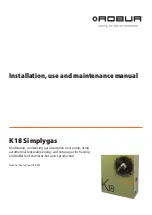
Warnings
Installation, use and maintenance manual – K18 Simplygas
5
III
or mental disabilities or persons with poor knowledge
and experience with use of the appliance.
Gas component tightness
Before performing any operation on gas ducting compo-
nents, close the gas valve.
Upon completing any procedure, perform the tightness
test according to regulations in force.
Gas smell
If you smell gas:
Do not use electrical devices such as telephones, mul-
timeters or other equipment that may cause sparks next
to the appliance.
Shut off the gas supply by turning the valve off.
Switch off the power supply via the external disconnect
switch in the power supply electrical panel.
Use a telephone away from the appliance to ask for inter-
vention from qualified personnel.
Poisoning
Ensure the flue gas ducts are tightness and compliant
with the regulations in force.
Upon completing any procedure, ensure the tightness of
the components.
Moving parts
The appliance contains moving parts.
Do not remove guards during operation, and in any case
prior to disconnecting the power supply.
Burn hazard
The appliance contains very hot parts.
Do not open the appliance and do not touch internal
components before the appliance has cooled down.
Do not touch the flue gas exhaust before it has cooled
down.
Pressure vessels
The appliance has a sealed circuit classified as pres-
sure vessel, the tightness of which is tested by the
manufacturer.
Do not carry out any intervention on the sealed circuit or
on the appliance's valves.
Water-ammonia solution
The unit uses the ammonia-water absorption cycle. The
water-ammonia solution is contained in the tightness
circuit. The solution is harmful for health if it is ingested,
inhaled or comes in contact with the skin.
In the event of coolant leak keep away and disconnect
the power and gas supply (only if it is possible to do so
with no danger).
Ask for TAC intervention.
Electrocution hazard
Disconnect the electrical power supply before any oper-
ation on appliance components.
For electrical connections exclusively use compli-
ant components and according to the specifications
provided by the manufacturer.
Ensure the appliance cannot be accidentally switched
back on.
Earthing
Electrical safety depends on effective earthing system,
correctly connected to the appliance and installed ac-
cording to the regulations in force.
Distance from combustible or flammable materials
Do not deposit flammable materials (paper, diluents,
paints, etc.) near the appliance.
Limescale and corrosion
Depending on the chemical/physical properties of the
system water, limescale or corrosion may damage the
appliance (Paragraph 3.8
Check system sealing.
Avoid frequent top-ups.
Chloride concentration
The concentration of chlorides or free chlorine in the
system water must not exceed the values in Table
3.2
Aggressive substances in the air
Halogenated hydrocarbons containing chlorine and flu-
orine compounds cause corrosion. The air of the installa-
tion site must be free from aggressive substances.
Acid flue gas condensate
Discharge the acid condensate of combustion flue gas,
as indicated in Paragraph 3.12
p. 29, in compliance
with current exhaust regulations.
Switching the appliance off
Disconnecting the power supply while the appliance
is running may cause permanent damage to internal
components.
Except in the event of danger, do not disconnect the
power supply to switch off the appliance, but always
and exclusively act through the provided control device
for heating service (OQLT021, OCDS007, or external re-
quest) or for DHW service (OQLT021 or external request).
In the event of failure
Operations on internal components and repairs may
exclusively be carried out by a TAC, using only original
parts.
In the event of failure of the appliance and/or breakage
of any component, do not attempt to repair and/or re-
store and immediately contact the TAC.
Routine maintenance
Proper maintenance assures the efficiency and good op-
eration of the appliance over time.
Maintenance must be performed according to the man-
ufacturer's instructions (see Chapter 7
p. 48) and in




















